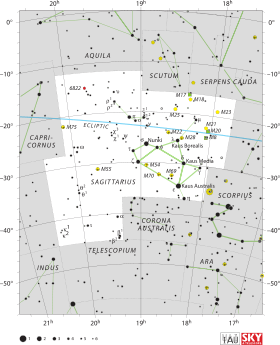Alpha Sagittarii
 | |
| Observation data Epoch J2000 Equinox J2000 | |
|---|---|
| Constellation | Sagittarius |
| Right ascension | 19h 23m 53.17483s[1] |
| Declination | −40° 36′ 57.3705″[1] |
| Apparent magnitude (V) | +3.97[2] |
| Characteristics | |
| Spectral type | B8 V[3] |
| U−B color index | −0.33[2] |
| B−V color index | −0.10[2] |
| Astrometry | |
| Radial velocity (Rv) | −0.7[4] km/s |
| Proper motion (μ) | RA: +30.49[1] mas/yr Dec.: −119.21[1] mas/yr |
| Parallax (π) | 17.94 ± 0.22[1] mas |
| Distance | 182 ± 2 ly (55.7 ± 0.7 pc) |
| Absolute magnitude (MV) | +0.23[5] |
| Details | |
| Mass | 2.95[6] M☉ |
| Radius | 2.49 R☉ |
| Luminosity | 117[7] L☉ |
| Surface gravity (log g) | 4.11[6] cgs |
| Temperature | 12,387±421[6] K |
| Metallicity [Fe/H] | −0.02[8] dex |
| Rotational velocity (v sin i) | 71[6] km/s |
| Age | 33[6] Myr |
| Other designations | |
| Database references | |
| SIMBAD | data |
Alpha Sagittarii (α Sagittarii, abbreviated Alpha Sgr, α Sgr), also named Rukbat,[9] is a star in the constellation of Sagittarius.
Properties
Alpha Sagittarii is a blue, class B dwarf star. It does not appear particularly bright in the sky to the naked eye, with a visual apparent magnitude of +3.97. However, this is due to its distance; in reality, the star is more than double the effective temperature of the Sun and nearly three times as massive, with a luminosity in visible wavelengths about 117 times greater than that of the Sun. Based on an excess emission of infrared radiation, it may have a debris disk, much like Vega.[8]
This is a single-lined spectroscopic binary system. The ROSAT All Sky Survey discovered that Alpha Sagittarii is emitting an excess flux of X-rays, which is not expected to originate from a star of this spectral class. The most likely explanation is that the companion is an active pre-main sequence star or else a star that has just reached the main sequence.[10]
Nomenclature
α Sagittarii (Latinised to Alpha Sagittarii) is the star's Bayer designation. It is unclear why Bayer designated this star as the alpha, rather than Epsilon Sagittarii or Sigma Sagittarii. This led some old star charts to occasionally depict Alpha and Beta Sagittarii as much brighter than they are in reality, as they are invisible from northern Europe, being too far south to see there.
The star bore the traditional names Rukbat and Alrami, derived from the Arabic rukbat al-rāmī 'the knee of the archer'. The star Delta Cassiopeiae also bore the traditional names Ruchbah or Rukbat, from the Arabic word ركبة rukbah meaning "knee". In 2016, the International Astronomical Union organized a Working Group on Star Names (WGSN)[11] to catalog and standardize proper names for stars. The WGSN's first bulletin of July 2016[12] included a table of the first two batches of names approved by the WGSN; which included Rukbat for this star (Delta Cassiopeiae was later given the name Ruchbah[9]).
In Chinese, 天淵 (Tiān Yuān), meaning Celestial Spring, refers to an asterism consisting of Alpha Sagittarii, Beta¹ Sagittarii and Beta² Sagittarii. Consequently, Alpha Sagittarii itself is known as 天淵三 (Tiān Yuān sān, English: the Third Star of Celestial Spring.)[13]
This star, together with Beta¹ Sagittarii and Beta² Sagittarii, were Al Ṣuradain (ألسردين), the two Surad, desert birds.[14]
See also
References
- 1 2 3 4 5 van Leeuwen, Floor (November 2007), "Validation of the new Hipparcos reduction", Astronomy and Astrophysics, 474 (2): 653–664, arXiv:0708.1752v1, Bibcode:2007A&A...474..653V, doi:10.1051/0004-6361:20078357 Note: see VizieR catalogue I/311.
- 1 2 3 Johnson, H. L.; et al. (1966), "UBVRIJKL photometry of the bright stars", Communications of the Lunar and Planetary Laboratory, 4 (99), Bibcode:1966CoLPL...4...99J
- ↑ Buscombe, W. (1962), "Spectral classification of Southern fundamental stars", Mount Stromlo Observatory Mimeogram, 4, Bibcode:1962MtSOM...4....1B
- ↑ Evans, D. S. (June 20–24, 1966), Batten, Alan Henry; Heard, John Frederick, eds., The Revision of the General Catalogue of Radial Velocities, University of Toronto: International Astronomical Union, Bibcode:1967IAUS...30...57E
- ↑ Anderson, E.; Francis, Ch. (2012), "XHIP: An extended hipparcos compilation", Astronomy Letters, 38 (5): 331, arXiv:1108.4971, Bibcode:2012AstL...38..331A, doi:10.1134/S1063773712050015.
- 1 2 3 4 5 David, Trevor J.; Hillenbrand, Lynne A. (2015), "The Ages of Early-Type Stars: Strömgren Photometric Methods Calibrated, Validated, Tested, and Applied to Hosts and Prospective Hosts of Directly Imaged Exoplanets", The Astrophysical Journal, 804 (2): 146, arXiv:1501.03154, Bibcode:2015ApJ...804..146D, doi:10.1088/0004-637X/804/2/146.
- ↑ Zorec, J.; Royer, F. (January 2012), "Rotational velocities of A-type stars. IV. Evolution of rotational velocities", Astronomy & Astrophysics, 537: A120, arXiv:1201.2052, Bibcode:2012A&A...537A.120Z, doi:10.1051/0004-6361/201117691.
- 1 2 Saffe, C.; et al. (October 2008), "Spectroscopic metallicities of Vega-like stars", Astronomy and Astrophysics, 490 (1): 297–305, arXiv:0805.3936, Bibcode:2008A&A...490..297S, doi:10.1051/0004-6361:200810260
- 1 2 "IAU Catalog of Star Names". Retrieved 28 July 2016.
- ↑ Hubrig, S.; et al. (June 2001), "Search for low-mass PMS companions around X-ray selected late B stars", Astronomy and Astrophysics, 372: 152–164, arXiv:astro-ph/0103201, Bibcode:2001A&A...372..152H, doi:10.1051/0004-6361:20010452
- ↑ "IAU Working Group on Star Names (WGSN)". Retrieved 22 May 2016.
- ↑ "Bulletin of the IAU Working Group on Star Names, No. 1" (PDF). Retrieved 28 July 2016.
- ↑ (in Chinese) AEEA (Activities of Exhibition and Education in Astronomy) 天文教育資訊網 2006 年 7 月 2 日
- ↑ Allen, R. H. (1963). Star Names: Their Lore and Meaning (Reprint ed.). New York: Dover Publications Inc. p. 357. ISBN 0-486-21079-0. Retrieved 2012-09-04.
External links
- Alpha Sagittarii on WikiSky: DSS2, SDSS, GALEX, IRAS, Hydrogen α, X-Ray, Astrophoto, Sky Map, Articles and images